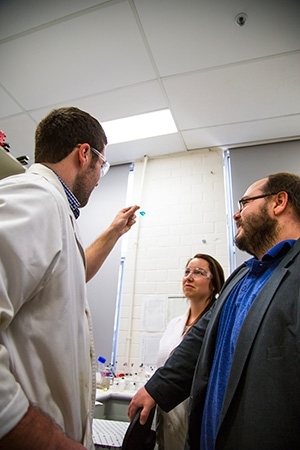Chemists click onto promising TB treatment
Research news
Researchers at Deakin University have stumbled across a promising discovery that could help to combat the current global tuberculosis pandemic, which is causing tens of thousands of deaths each year in many low and middle income countries.
TB is one of the world’s most deadly communicable diseases. According to the World Health Organisation (WHO), two billion people - one third of the world's population - are infected with the bacillus that causes the disease.
WHO estimates that around nine million people developed active TB in 2013, and 1.5 million died from the disease, with more than half of these deaths occurring in the South East Asia and Western Pacific regions.
Deakin materials chemist Dr Luke Henderson and his team have discovered a promising group of molecules that target and kill TB bacteria that could lead to a much-needed new treatment option.
The finding is causing excitement amongst the chemistry and medical communities and was recently featured on the cover of the prestigious international journal “ChemMedChem.”
The finding marks the team’s second ground-breaking discovery. Two years ago, they synthesised 50 previously unknown molecules. Several of these showed anticancer activity similar to the current gold standard therapies used worldwide for treating prostate cancer. These extremely promising cancer-fighting molecules are currently undergoing further research, to determine their potential for clinical trials.
The TB-fighting molecules were discovered among the same group of molecules. Over the past 12 months, Dr Henderson, a Senior Research Fellow in the Institute for Frontier Materials, has been researching their TB-fighting potential with his PhD students Jarrad Altimari and Samantha Hockey.
The team has also received support from the US National Institute of Allergy and Infectious Diseases, which tested the effect of the molecules on TB bacteria.
“While we were working on a group of 25 to 30 compounds, six of the most active components proved to be able to inhibit the growth of TB at a very low concentration (less than 10 micrograms per litre), which is extremely effective,” explained Dr Henderson.
“While there is still a long road ahead before a drug would be ready for commercialisation, we are very excited about its potential. Its arrival on the market could be crucial, given the disease’s growing resistance to current drug treatments.
“The good thing about these molecules is that we can easily generate and modify a lot more. We can synthesise them in one day, which means that we can speed up the research process.”
The researchers have used the pioneering approach to chemistry called “click chemistry” that was introduced to the world by Nobel Laureate, Professor KB Sharpless in 2001. Click chemistry enables substances to be generated quickly by joining small modular units together, like Lego, and is proving to have outstanding applications in areas ranging from materials sciences and polymer chemistry, to pharmaceuticals.
Dr Henderson explained that, while annual TB fatalities are declining, concern is growing that increasing drug resistance and a lack of new drugs could reverse that trend.
“The disease is evolving resistance to the two frontline drugs that have been used to treat TB for almost 30 years, Isoniazid and Rifampicin. Now, around half a million of all TB cases are multi-drug resistant and around 10 per cent of these are extremely drug resistant,” he said.
“The first new drug in 30 years, Bedaquiline, was made available in 2012, but, unfortunately, it has a ‘black box’ warning, which is the most serious warning able to be given by the FDA.”
“The disease is well under control in Australia (less than one per cent), due to our excellent health care system and geographical isolation, but human movement across the globe and increasing drug resistance mean that TB also poses a potential risk to Australia.”
He added that the team’s next step will be to focus on understanding how the molecules select and kill TB bacteria and whether they may cause side effects.
Share this story
 Chemical breakthrough: Deakin researchers, Jarrad Altimari, Samantha Hockey and Dr Luke Henderson.
Chemical breakthrough: Deakin researchers, Jarrad Altimari, Samantha Hockey and Dr Luke Henderson.
